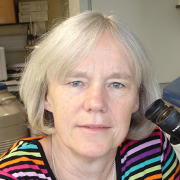Elizabeth Robertson
Professor of Developmental Biology
Transcriptional regulators of mammalian development
Our research exploits mouse genetics to investigate the key signalling cues and transcriptional regulators governing cell fate decisions in the developing mammalian embryo. In particular, we have been studying the TGF family of secreted growth factors, including the ligand Nodal, and its downstream effector Smad2, responsible for patterning the anterior-posterior or "head-tail" axis of the embryo. Similarly, BMP/Smad1 signals are essential for germ cell specification.
 Blimp1 expression marks developing forelimb buds, secondary heart field and gut tube. Blimp1 expression marks developing forelimb buds, secondary heart field and gut tube. |
 Nodal/Smad2 activate Eomes upstream of Mesp1/2 mesoderm or later in the endoderm Nodal/Smad2 activate Eomes upstream of Mesp1/2 mesoderm or later in the endoderm |
Our recent work has focused on target genes of these pathways that play critical roles in diverse tissue contexts. We are investigating how the T-box transcription factor Eomesodermin functions downstream of Nodal/Smad2 to orchestrate cell fate allocation during gastrulation, and governs trophoblast stem cell maintenance. Additionally, we are studying Blimp1, a PR-SET domain Zn-finger transcriptional repressor, downstream in the BMP/Smad1 pathway. We aim to understand how this master regulator influences the local chromatin landscape at its target genes during trophoblast giant cell differentiation in the developing placenta, and globally regulates post-natal reprogramming of gene expression in the intestinal epithelium.
We use transgenic and embryonic stem (ES) cell technologies to dissect the conserved cis-acting regulatory elements present at the promoter and enhancer regions of these genes that direct their temporally and spatially restricted expression patterns. We have generated novel knock-in mouse strains for in vivo live cell imaging and fate mapping studies. A panel of mutant ES and TS cell lines is available for transcriptional profiling and ChIP experiments.
Our long-term goal is to learn more about the molecular and cellular mechanisms that govern tissue morphogenesis in an orderly fashion as cells diversity and acquire specialized functions within the embryo.
Recent publications
-
Publisher Correction: The T-box transcription factor Eomesodermin governs haemogenic competence of yolk sac mesodermal progenitors.
Journal article
Harland LTG. et al, (2021), Nat Cell Biol
-
Kathryn V. Anderson (1952-2020).
Journal article
Arkell RM. et al, (2021), Nat Cell Biol
-
The T-box transcription factor Eomesodermin governs haemogenic competence of yolk sac mesodermal progenitors.
Journal article
Harland LTG. et al, (2021), Nat Cell Biol, 23, 61 - 74
-
The transcriptional repressor Blimp1/PRDM1 regulates the maternal decidual response in mice.
Journal article
Goolam M. et al, (2020), Nat Commun, 11
-
CytoCensus, mapping cell identity and division in tissues and organs using machine learning.
Journal article
Hailstone M. et al, (2020), Elife, 9


